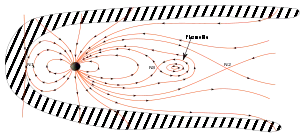Plasmoïde
Un plasmoïde est une structure autoconfinée constituée d'un plasma et d'un champ magnétique qui en assure la cohésion. Les plasmoïdes ont été proposés pour expliquer divers phénomènes naturels comme la foudre en boule[1], les bulles magnétiques dans la magnétosphère[2] ainsi que certains objets présents dans les queues de comètes[3], dans le vent solaire[4],[5], dans l'atmosphère du Soleil[6] et dans la couche de courant héliosphérique. Des plasmoïdes sont produits en laboratoire par divers dispositifs, comme les configurations à champ inverse (Field-Reversed Configurations), les sphéromaks et les focalisateurs de plasma dense.
Pour les plasmoïdes de KDE, voir Plasma (KDE).

Origine du mot
Le mot plasmoïde (plasmoid en anglais) a été créé en 1956 par Winston Bostick (1916-1991) pour désigner une « entité plasma-magnétique »[7] :
« Le plasma est émis, non comme une goutte informe, mais sous la forme d'un tore. Nous prendrons la liberté d'appeler cette structure toroïdale un plasmoïde, mot qui signifie entité plasma-magnétique. Le mot plasmoïde sera utilisé comme terme générique pour toutes les entités plasma-magnétiques[N 1]. »
Caractéristiques des plasmoïdes
Bostick présente ainsi les plasmoïdes[7] :
« Les plasmoïdes se présentent comme des cylindres de plasma allongés dans la direction du champ magnétique. Les plasmoïdes possèdent un moment magnétique mesurable, une vitesse de déplacement mesurable, un champ électrique transverse et une taille mesurable. Les plasmoïdes peuvent interagir entre eux, apparemment en se réfléchissant mutuellement. On peut aussi faire s'incurver leurs orbites l'une vers l'autre. On peut faire spiraler des plasmoïdes jusqu'à leur arrêt complet en les projetant dans un gaz à une pression proche de 10−3 mmHg. On peut également faire éclater mutuellement des plasmoïdes en morceaux. Il existe peu de preuves pour appuyer l'hypothèse qu'ils puissent se scinder et posséder un mouvement de rotation[N 2]. »
Applications en astrophysique
Bostick prolonge sa démarche en appliquant sa théorie des plasmoïdes aux phénomènes astrophysiques. Dans une publication de 1958[8], il applique les lois d'échelle en physique des plasmas à des paires de plasmoïdes projetés par un canon à plasma (un dispositif « dense plasma focus »), qui interagissent de façon à simuler un modèle de galaxie en formation[9],[10].
Notes
- Citation originale : « The plasma is emitted not as an amorphous blob, but in the form of a torus. We shall take the liberty of calling this toroidal structure a plasmoid, a word which means plasma-magnetic entity. The word plasmoid will be employed as a generic term for all plasma-magnetic entities. »
- Citation originale : « Plasmoids appear to be plasma cylinders elongated in the direction of the magnetic field. Plasmoids possess a measurable magnetic moment, a measurable translational speed, a transverse electric field, and a measurable size. Plasmoids can interact with each other, seemingly by reflecting off one another. Their orbits can also be made to curve toward one another. Plasmoids can be made to spiral to a stop if projected into a gas at about 10−3 mmHg pressure. Plasmoids can also be made to smash each other into fragments. There is some scant evidence to support the hypothesis that they undergo fission and possess spin. »
Sources
- (en) Cet article est partiellement ou en totalité issu de l’article de Wikipédia en anglais intitulé « Plasmoid » (voir la liste des auteurs).
Références
- Silberg 1962, p. 4941
- Hones 1976
- Roosen, R. G.; Brandt, J. C., "Possible Detection of Colliding Plasmoids in the Tail of Comet Kohoutek" (1976), Study of Comets, Proceedings of IAU Colloq. 25, held in Greenbelt, MD, 28 October - 1 November, 1974. Edited by B. D. Donn, M. Mumma, W. Jackson, M. A'Hearn, and R. Harrington. National Aeronautics and Space Administration SP 393, 1976., p.378
- Lemaire et Roth 1981
- Wang et al. 1988
- Cargill, P. J.; Pneuman, G. W., "The energy balance of plasmoids in the solar atmosphere" (1986), Astrophysical Journal, Part 1 (ISSN 0004-637X), vol. 307, Aug. 15, 1986, p. 820-825.
- Bostick 1956
- Bostick, Winston H., "Possible Hydromagnetic Simulation of Cosmical Phenomena in the Laboratory" (1958) Cosmical Gas Dynamics, Proceedings from IAU Symposium no. 8. Edited by Johannes Martinus Burgers and Richard Nelson Thomas. International Astronomical Union. Symposium no. 8, p. 1090
- W. L. Laurence, "Physicist creates universe in a test tube," New York Times, p. 1, Dec. 12, 1956.
- Bostick, W. H., "What laboratory-produced plasma structures can contribute to the understanding of cosmic structures both large and small" (1986) IEEE Transactions on Plasma Science (ISSN 0093-3813), vol. PS-14, Dec. 1986, p. 703-717.
Bibliographie
- (en) Winston H. Bostick, « Experimental Study of Ionized Matter Projected across a Magnetic Field », Physical Review, vol. 104, , p. 292-299 (lire en ligne)
- (en) Paul A. Silberg, « Ball Lightning and Plasmoids », Journal of Geophysical Research, vol. 67,
- (en) E. W. Hones, Physics of solar planetary environments; Proceedings of the International Symposium on Solar-Terrestrial Physics : The magnetotail - Its generation and dissipation, vol. 2,
- (en) J. Lemaire et M. Roth, « Differences between solar wind plasmoids and ideal magnetohydrodynamic filaments », Planetary and Space Science, vol. 29, , p. 843-849 (lire en ligne)
- (en) S. Wang, L. C. Lee, C. Q. Wei et S.-I. Akasofu, « A mechanism for the formation of plasmoids and kink waves in the heliospheric current sheet », Solar Physics, vol. 117, no 1, , p. 157-169 (ISSN 0038-0938)
- (en) Bostick, W. H., "Experimental Study of Plasmoids", Electromagnetic Phenomena in Cosmical Physics, Proceedings from IAU Symposium no. 6. Edited by Bo Lehnert. International Astronomical Union. Symposium no. 6, Cambridge University Press, p. 87